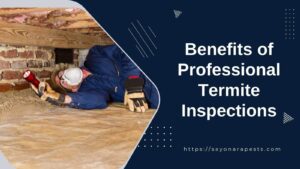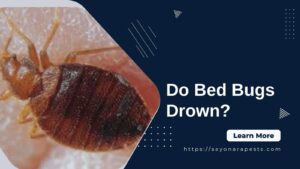Termite prevention is an essential aspect of home maintenance that every homeowner should prioritize. These pesky insects can cause severe damage to the structural integrity of your home, resulting in expensive repairs and restoration.
It is vital to be proactive and take preventative measures to keep your home safe from termite infestations. The goal of this article is to provide homeowners with valuable tips and advice on termite prevention.
By implementing these preventive measures, you can safeguard your home from termite damage and avoid costly repairs in the long run.
Termite Prevention Tips
Tip #1: Inspect Your Property Regularly
The importance of regular property inspection cannot be overstated when it comes to preventing termite infestations. Therefore, it is critical to conduct regular inspections of your property to identify any signs of termite activity early on.
Inspecting your property regularly is especially important if you live in an area known to have a high termite population. It is recommended that homeowners in such areas have their property inspected at least once a year by a professional pest control company.
Tip #2: Repair Any Leaks or Moisture Problems
One of the primary steps in preventing termites is to repair any leaks or moisture problems in your home. Moisture is a significant attraction for termites, and it can lead to wood decay, which can make your home more susceptible to infestations.
To prevent termites from infiltrating your home, it is essential to keep your property dry and free from moisture.
It is also important to keep your gutters clean and free from debris to prevent water from pooling around your foundation. You can also install proper drainage systems to redirect water away from your home.
Tip #3: Seal Cracks And Crevices
One of the primary measures to prevent termites from entering a building is to seal any cracks and crevices that may exist in the foundation or walls.
Sealing cracks and crevices can be a challenging task, as they may be located in hard-to-reach areas of the building. However, it is essential to ensure that every possible entry point is sealed to prevent termites from entering.
Some common areas where cracks and crevices may be found include the foundation, windows, doors, and roof. If not adequately sealed, termites can enter through these openings and start to create colonies, which can cause significant structural damage to the building over time.
Tip #4: Maintain Proper Ventilation
Poor ventilation can lead to excess moisture buildup, which is a magnet for termites. Moisture not only attracts termites but also provides them with the ideal environment to thrive, reproduce and build their nests.
Adequate ventilation helps to prevent the buildup of moisture in the home by allowing for proper airflow. This can be achieved by installing vents in key areas of the home, such as the attic and crawl spaces.
Tip #5: Keep Your Yard Clean and Tidy
The upkeep of one’s yard is a critical component in the fight against termite infestations, and it is imperative to keep it clean and tidy. By removing clutter and debris, one eliminates potential hiding spots and food sources for termites.
This creates a less attractive environment for termites, making it less likely that they will infest the area.
Tip #6: Keep Shrubs and Trees Trimmed
By keeping your shrubs and trees trimmed, you can reduce the likelihood of termites finding a way into your property. Overgrown vegetation can provide a perfect hiding place for termites, allowing them to access your home or building unnoticed.
Additionally, trees and shrubs that are in close proximity to your property can provide a bridge for termites to travel from the ground into your walls, roof, or foundation.
When vegetation is allowed to become overgrown, it can create shaded and damp areas that are perfect breeding grounds for termites and other pests.
Tip #7: Remove Dead Wood
Deadwood is a common source of food for termites, making it a high-risk area for infestation. Termites can quickly move from the dead wood to your home, causing significant damage to the structure of your property.
Deadwood can come in various forms, including dead tree branches, stumps, and other organic debris. Removing dead wood is, therefore, an essential step in preventing termite infestation.
Deadwood removal also helps to reduce the risk of other pests that thrive in decomposing organic matter, such as mosquitoes and rodents.
Tip #8: Create a Barrier Between Your Home and Soil
Creating a barrier between your home and the soil is one of the most effective ways to prevent termites from infesting your property.
To create a barrier between your home and the soil, you can start by ensuring that your yard is properly graded and that water is drained away from your home’s foundation. This helps to reduce the moisture content of the soil surrounding your home, which can significantly deter termite infestations.
Additionally, you can install a physical barrier, such as a metal mesh or a concrete slab, between the soil and your home’s foundation to prevent termites from gaining access to your property.
Tip #9: Use Chemical Barriers To Prevent Termites
Chemical barriers are one of the most popular termite prevention products available on the market. They are designed to create a physical barrier around the perimeter of your property, preventing termites from entering and infesting your home.
These barriers typically contain insecticides that are toxic to termites, and they are applied to the soil surrounding your home. When termites come into contact with the barrier, they are either killed or repelled, preventing them from entering your home.
Tip #10: Use Baiting Systems To Kill Termites
One popular option for termite prevention is the use of baiting systems. These systems work by luring termites to bait stations that contain toxic substances that are designed to kill the insects.
The idea behind baiting systems is to intercept termites before they have a chance to make it to your home or other structures on your property.
If you’re looking for a natural and environmentally-friendly way to prevent termites, baiting systems can be a great option to consider.
Tip #11: Apply Borates To Your Wooden Materials
Borate treatments are a highly effective way to prevent termite infestations in homes and other structures. Borates are a type of mineral salt that is derived from boron, which is a naturally occurring element found in rocks, soil, and water.
When borates are applied to wood, they penetrate the surface and create a protective barrier that termites cannot penetrate. This barrier can last for many years, making borate treatments a long-lasting and cost-effective solution for termite prevention.
Tip #12: Use Vinegar And Water Mixture To Repel Termites
One of the simplest homemade termite repellents is a mixture of vinegar and water. Simply mix equal parts of vinegar and water in a spray bottle and spray it around the areas of your home where you suspect termites may be present.
The strong scent of vinegar is believed to be effective in repelling termites and deterring them from entering your home.
Tip #13: Use Orange Oil As A Repellant Spray
Another effective homemade termite repellent is a mixture of orange oil and water. Orange oil is derived from orange peels and is known to have insecticidal properties.
Mix about 3-4 tablespoons of orange oil with a gallon of water and spray it around your home. The scent of the orange oil is believed to be unpleasant to termites and may help to keep them at bay.
Tip #14: Spray Neem Oil Around Your Home
If you have access to neem oil, this can also be used as a natural termite repellent. Neem oil is derived from the neem tree and is known for its insecticidal properties. Mix a tablespoon of neem oil with a gallon of water and spray it around your home.
The strong scent of neem oil is believed to be effective in repelling termites and preventing them from entering your home
Tip #15: Use Nematodes To Feed On Termites
One popular natural termite prevention method is the use of nematodes. These are tiny, parasitic worms that are natural predators of termites. When introduced to the soil around your home, nematodes will seek out and feed on termite larvae and adults, effectively controlling their populations.
Tip #16: Apply Diatomaceous Earth Around Your House
Another effective natural termite prevention method is the use of diatomaceous earth. This substance is made up of the fossilized remains of tiny aquatic organisms and is completely non-toxic to humans and pets.
When applied around the perimeter of your home or in areas where termites are likely to be present, diatomaceous earth will puncture the exoskeletons of termites, causing them to dehydrate and die.
Tip #17: Use Termite-Resistant Materials In Building Your House
When it comes to protecting your home from termites, prevention is key. Building a termite-resistant home can save you time, money, and the headache of dealing with a termite infestation down the line.
But how exactly do you go about constructing a home that’s resistant to these pesky pests?
The first step in building a termite-resistant home is to use termite-resistant materials. This includes using concrete, steel, or brick instead of wood for the foundation, walls, and framing.
While these materials may be more expensive than wood, they’re much less susceptible to termite damage.
Tip #18: Pick A Termite-Free Location For Your Home
Termites thrive in moist environments, so it’s important to choose a location that’s not prone to excessive moisture. This means avoiding areas near swamps, wetlands, or other bodies of water.
Tip #19: Hire a Professional When Needed
It’s crucial to hire professional termite services as soon as you suspect a termite infestation. Delaying the process can result in the infestation spreading further, leading to more significant damage and more costly repairs.
By acting quickly and hiring a professional, you can minimize the potential damage and get your property back to its original state in no time.
In conclusion, preventing termite infestation is crucial in maintaining the safety and structural integrity of your home. Regular inspection and maintenance, landscaping and yard maintenance, prevention products, hiring a professional, DIY methods, and termite prevention during construction are all effective methods in preventing termite infestation.
Investing in preventative measures is essential in avoiding the costly repairs associated with termite damage, and choosing environmentally safe prevention methods can help reduce the environmental impact of termite prevention.











